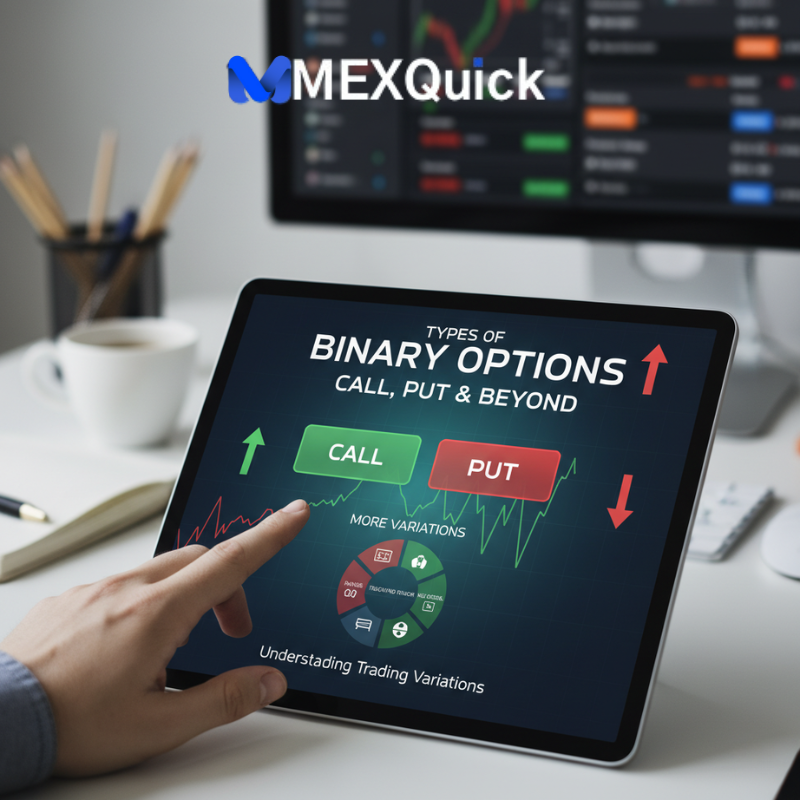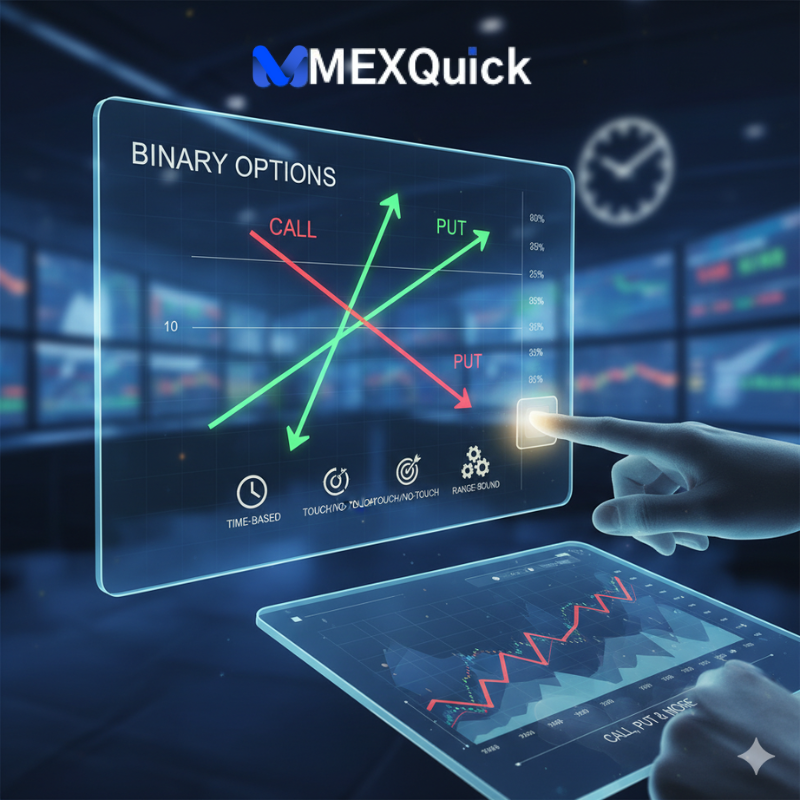
Ever felt overwhelmed by all the different types of binary options out there?
You’re not alone. When I first started, I thought it was just about guessing if a price would go up or down. But I quickly learned that understanding the different binary options types is the real key to moving from a gambler to a strategic trader.
Knowing your tools—Call and Put options, touch/no-touch, boundaries, and more—is what separates consistent performers from those who just blow up their accounts.
So, let’s break it all down. This is your no-fluff, beginner-friendly guide to the major types of trades and how to use them.
Understanding Binary Options: It’s All About a Simple Question
Before we dive into the specific binary options variations, let’s get one thing crystal clear.
A binary option is a financial instrument that asks a simple “yes” or “no” question: Will Asset X be above Price Y at Time Z?
- “Yes” = You win a fixed payout (often 70-90% of your investment).
- “No” = You lose your initial investment.
It’s called “binary” because there are only two possible outcomes. It’s all or nothing. This simplicity is why it’s so popular, but it also demands a solid strategy. And that strategy starts with knowing which type of option to use and when.
The Foundation: What Are Call and Put Options?
If you only learn two types of binary options, make it these. Every other variation is built on this core concept.
A Call Option (also known as a “High” option) is your bet that the price of an asset (like gold, a stock, or a currency pair) will be ABOVE its current price when the option expires.
- Your Question: “Will the price go up before the deadline?”
- You Use It When: You’re bullish. You believe the market is trending upward or is about to rise based on your analysis.
A Put Option (also known as a “Low” option) is your bet that the price of an asset will be BELOW its current price when the option expires.
- Your Question: “Will the price go down before the deadline?”
- You Use It When: You’re bearish. You believe the market is trending downward or is about to fall.
Example: Let’s say Apple (AAPL) stock is currently trading at $170. You analyze the charts and expect some positive news to push the price up in the next hour.
- You buy a Call option on AAPL with a 1-hour expiration and a potential 80% payout.
- You invest $100.
- Result in 1 hour:
- AAPL is at $171: You win! Your trade is “in the money.” You get your $100 back plus an $80 profit ($180 total).
- AAPL is at $169.99 or lower: You lose. Your trade is “out of the money.” You lose your $100 investment.
It’s that simple. Call and Put are the bread and butter of trading options explained.
Beyond Basics: Key Variations of Binary Options
While Call/Put are the most common, brokers offer other binary options variations that can help you profit in different market conditions. Here are the main ones you need to know.
Exploring the Different Types of Trades
1. Touch/No-Touch Options
These options aren’t about where the price ends up, but whether it touches a specific target price at any point before expiration.
- One-Touch Option: You win if the market price touches the predetermined target price at least once before expiry. The target is usually set far away from the current price, but the potential payouts are much higher (sometimes 200-500%).
- When to Use: When you expect a strong, explosive price movement (e.g., after a major news event like an ECB interest rate decision).
- No-Touch Option: The opposite. You win if the market price does NOT touch the predetermined target price at any point before expiry.
- When to Use: When you expect the price to stay within a certain range and not experience high volatility.
2. Boundary/Range Options (Sometimes called Tunnel or Range Options)
This type asks whether the price of an asset will stay inside or outside a predetermined price channel (a upper and lower boundary) until expiration.
- In/Boundary Option: You win if the price stays inside the set boundary until expiry.
- Out/Boundary Option: You win if the price breaks outside of the set boundary (either above the top or below the bottom) at expiry.
When to Use: Perfect for markets that are consolidating or ranging sideways (In option) or for when you expect a major breakout in either direction (Out option).
3. 60-Second Options (Short-Term Options)
As the name implies, these options expire just 60 seconds after they are purchased. They are a more volatile and fast-paced version of the standard Call/Put option.
- When to Use: For experienced traders who can make quick decisions based on very short-term price fluctuations. Warning: These are extremely high-risk and can lead to rapid losses.
4. Ladder Options
These present a series of price levels (like rungs on a ladder) with different payout percentages. You predict whether the price will be above each rung at expiration. The higher the rung you choose for a Call, the higher the potential payout, but the lower the probability of success.
- When to Use: When you have a very strong conviction about how far the price will move and want to leverage that for a higher return.
To make this clearer, here’s a quick comparison table:
| Option Type | The Question You’re Asking | Best Market Condition |
| Call/Put | Will the price be above/below the current price at expiry? | Clear directional trend |
| One-Touch | Will the price hit a specific target level before expiry? | Strong, volatile momentum |
| No-Touch | Will the price avoid a specific target level before expiry? | Low volatility, ranging market |
| Boundary (In) | Will the price stay inside a channel until expiry? | Sideways, consolidating market |
| Boundary (Out) | Will the price break out of a channel by expiry? | High volatility, expecting a breakout |
| 60-Second | Will the price be above/below in the next 60 seconds? | Extreme short-term volatility |
Putting It Into Practice: How to Choose the Right Type for Your Strategy

You wouldn’t use a hammer to screw in a lightbulb. Similarly, you shouldn’t use a One-Touch option when the market is moving sideways.
Choosing the right tool is everything. Here’s a simple framework:
- Analyze the Market Condition First:
- Strong Uptrend/Downtrend? -> Use a standard Call or Put.
- Stuck in a Range? -> Consider a Boundary (In) or a No-Touch option.
- Expecting a Huge Breakout? -> A Boundary (Out) or One-Touch option could be perfect.
- No Clear Direction but High Volatility? -> This is tricky. Maybe avoid trading or use very small positions.
- Match the Option to Your Forecast: Your analysis should tell you not just the direction, but the strength and timing of the move. Your choice of option should reflect that.
- Start Simple: If you’re a beginner, stick to Call and Put options until you are consistently profitable. Master the foundation before you experiment with the more exotic variations of binary options.
Key Takeaways: Your Action Plan for Trading Binary Options Types
We’ve covered a lot of ground. Let’s simplify it.
- The Core: All binary options types are built on the simple “yes/no” premise of Call and Put options.
- The Variations: Options like Touch/No-Touch and Boundary allow you to profit from specific market conditions like high volatility or sideways movement.
- The Strategy: Your success hinges on correctly analyzing the market first and then selecting the binary option type that best fits that forecast. Don’t just force a Call/Put trade every time.
Your Action Plan:
- Open a Demo Account: This is non-negotiable. Practice with virtual money on your broker’s platform. Test every single one of these types of trades.
- Paper Trade: Before going live, write down your analysis, which option type you would use, and why. See if you’re right without risking capital.
- Start Small: When you go live, use small, consistent amounts of capital. Preserve your bankroll.
- Keep Learning: Understanding these binary options variations is a huge step. Now combine it with solid risk management and technical analysis to build a complete strategy.
The world of binary options is vast, but by mastering these different types, you equip yourself with the knowledge to trade with confidence, not just hope.
Now I’d love to hear from you: Which of these binary options types are you most excited to try out on a demo account? Let me know in the comments
